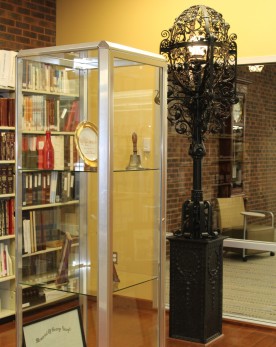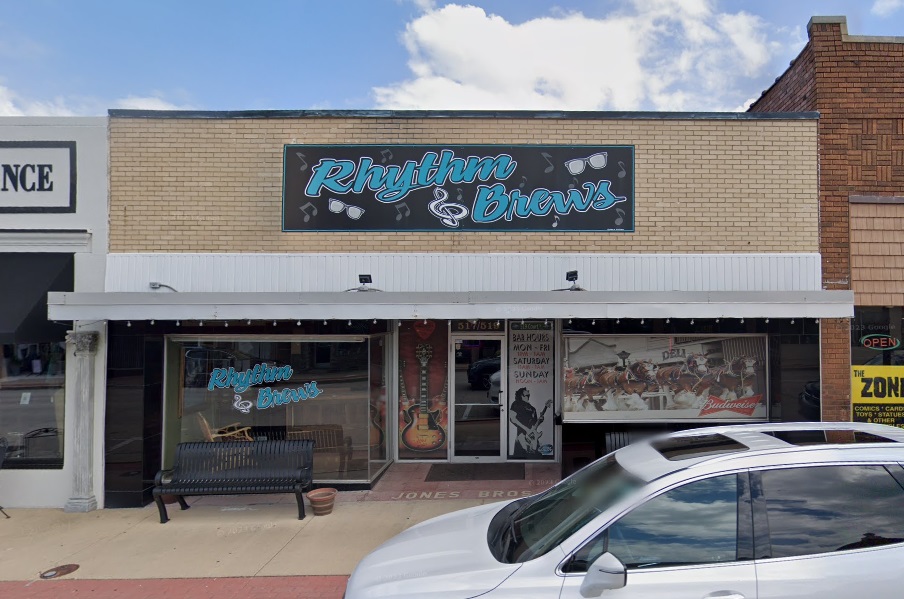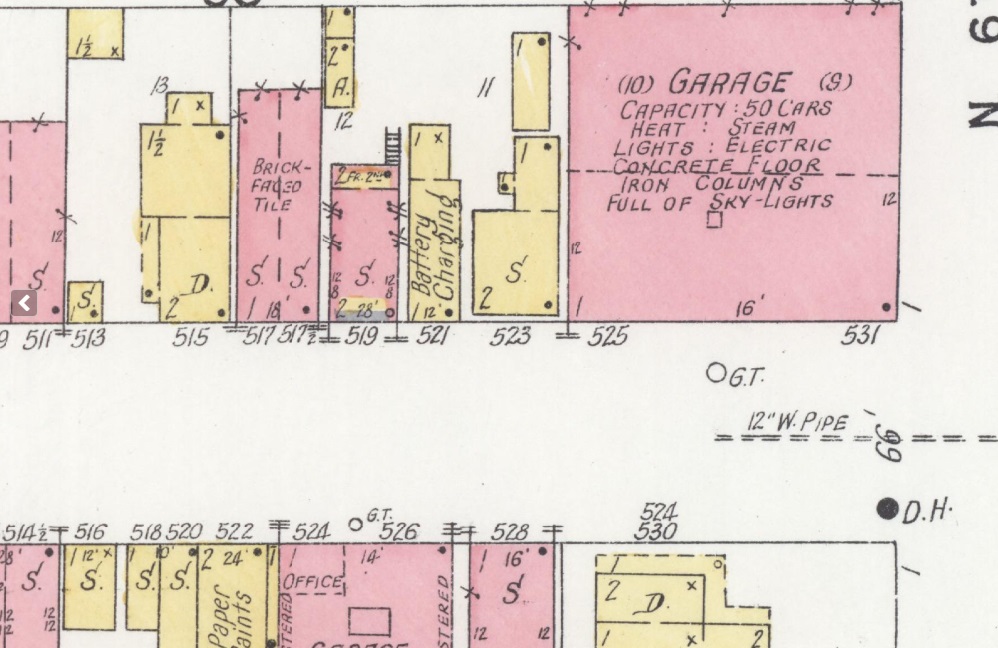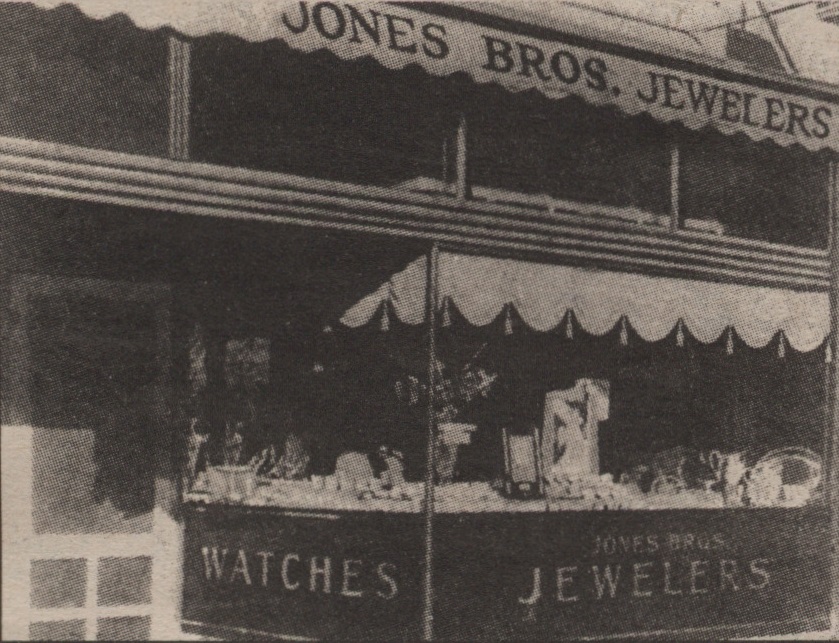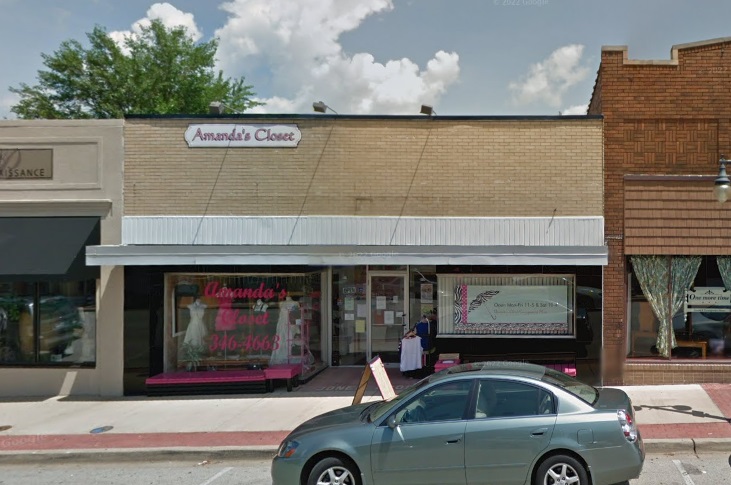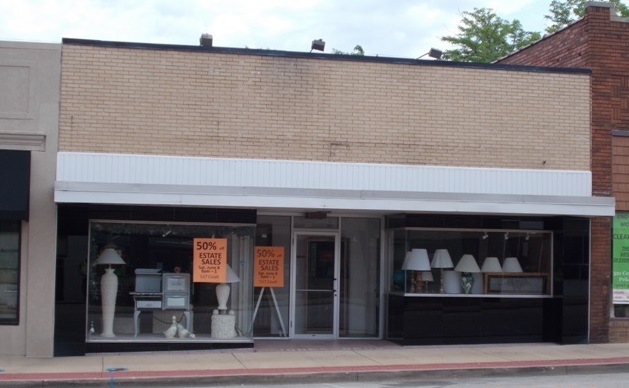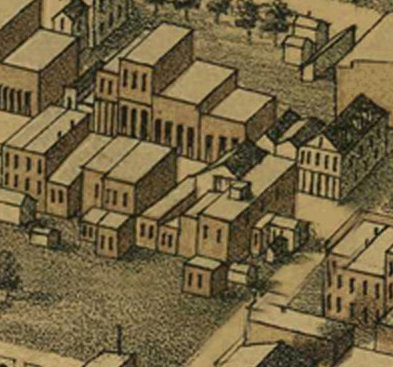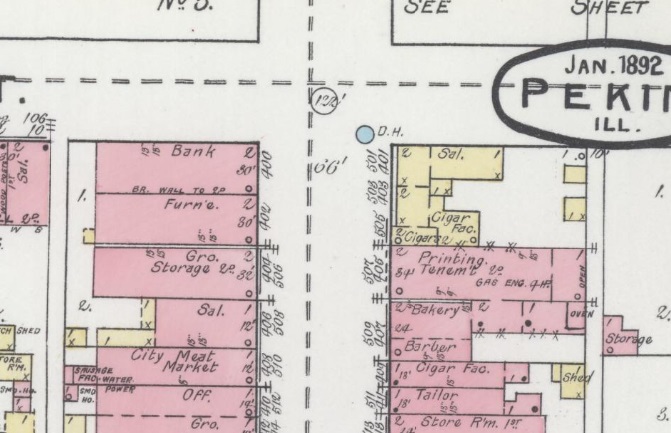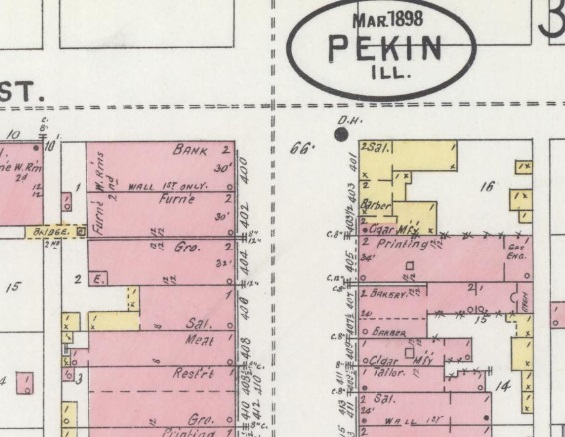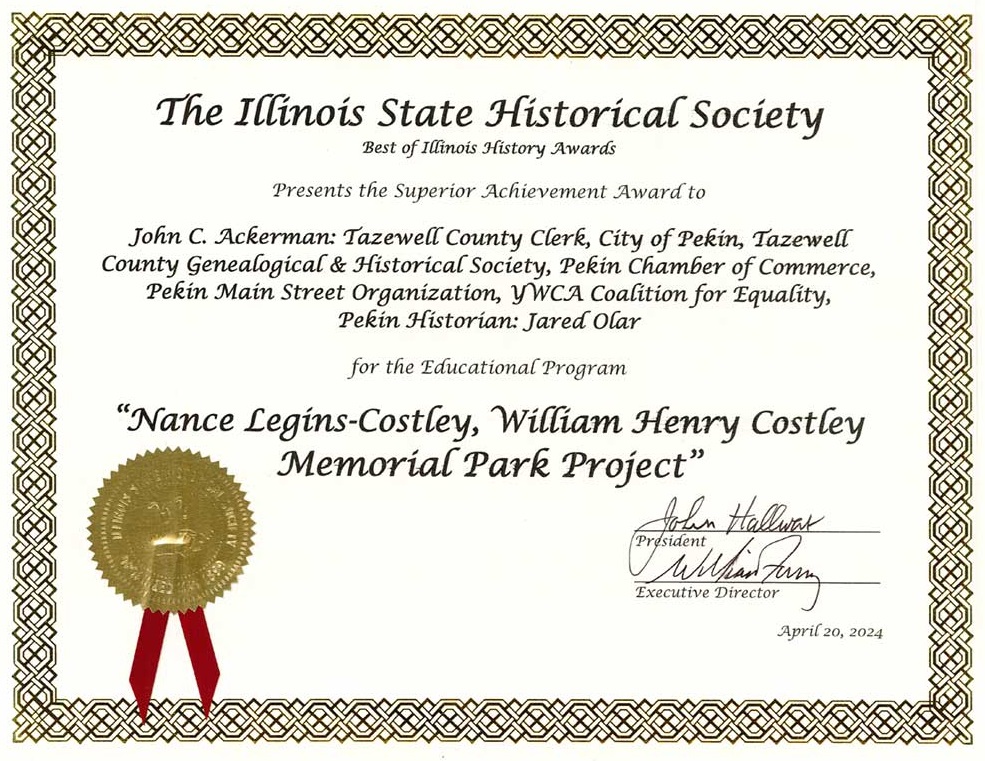The city of Pekin currently has four Illinois State Historical Society markers highlighting significant events and individuals in Pekin’s history. Those markers are:
1) The marker in Riverfront Park that commemorates the tragic wreck of the Riverboat Columbia on 5 July 1918.
2) The marker on the side of the former Pekin National Bank building at the intersection of Court and Capitol streets commemorating the founding of the Union League at that site on 25 June 1862.
As we noted last time, the dedication of a fifth ISHS marker is being planned for this Juneteenth, honoring the 12 African-American men of Pekin and Elm Grove Township who fought for an end to slavery in the 29th U.S. Colored Infantry during the Civil War.
But this week we will turn our attention to the Union League historical marker and to story behind it. As we have recalled before here at “From the History Room,” the founding of the Union League during the Civil War was one of the high points of Pekin’s history. In the initial stages of the Civil War pro-Confederacy and pro-slavery sentiment remained prominent even as far north as Peoria and Pekin (both communities having been founded by slave-owning families, though abolitionists were also present here from the start). Consequently, prior to the formation of the Union League “those who believed in the Union spoke often in whispers in Pekin streets and were wary and often afraid,” says the 1949 Pekin Centenary, because the pro-Confederacy Knights of the Golden Circle (from which the Ku Klux Klan developed after the war) was a menacing force in Pekin.
The idea of establishing a league in Pekin to support the Union cause is credited to the Rev. J. W. N. Vernon, the new minister of Pekin’s First Methodist Church, who had recently come to this community from Tennessee where similar leagues or secret societies had been formed. Besides Rev. Vernon, the founding members of the Union League were Richard Northcroft Cullom, former Illinois state senator; Dr. Daniel A. Cheever, abolitionist and Underground Railroad conductor; Charles Turner, Tazewell County state’s attorney; Henry Pratt, Delavan Township supervisor; Alexander Small, Deer Creek Township supervisor; George H. Harlow, Tazewell County circuit clerk; Jonathan Merriam, stock farmer who became a colonel in the Union army; Hart Montgomery, Pekin postmaster; John W. Glassgow, justice of the peace; and Levi F. Garrett, Pekin grocery store owner and baker.
After the Civil War, the Union League became a Republican Party social club, but would carry on its abolitionist legacy through support of civil rights for African-Americans.
The founding of the Union League was first commemorated by a plaque placed on the side of the old Smith Bank building on 7 Dec. 1920. Later the building housed Marty Perlman’s business, the Perlman Furniture Co., which was destroyed by a fire in Oct. 1968. But, as the Pekin Daily Times reported in an article dated 16 Aug. 1975, “Perlman pried the charred plaque off the east wall after the flames had been extinguished, had it reconditioned and saw that it was kept safely until it could be remounted in an appropriate place at a significant time.”
That time and place came on Tuesday, 19 Aug. 1975, when the old 1920 plaque was remounted in the lobby of Pekin National Bank (built on the site of the Smith Bank/Perlman Furniture Co. building) on the occasion of President Gerald R. Ford’s visit to Pekin to dedicate the Pekin Public Library and Everett M. Dirksen Center.
But a few days before that, the Illinois State Historical Society marker on the outside of the east wall of the Pekin National Bank had already been mounted. That plaque, donated by the Union League of America and the Illinois State Historical Society, was formally dedicated at the same time as the remounting of the 1920 plaque.
The story of the founding of the Union League in Pekin and their successful challenge to the Knights of the Golden Circle is told in a pamphlet published for the occasion of the 1920 plaque dedication by the old Tazewell County History Society. The pamphlet, entitled “Knights of the Golden Circle versus Union League of America,” contains the full text of the formal dedicatory address that was delivered at the Tazewell County Courthouse by Pekin pioneer historian and Civil War veteran William Henry Bates.
BROTHER PRESIDENT, LADIES AND GENTLEMEN:
We have assembled to dedicate the erection of a bronze tablet and pay tribute to the memory of those patriots who organized and were members of the first Council of the Union League of America instituted in the Northern States.
In order to give you a better understanding of the motive that led to the organization of the Union League of America, I feel it my duty, in as brief a manner as possible, to speak of the causes that called the Union-loving adherents of our grand galaxy of States, under the glorious Star and Stripes, to organize and pledge allegiance to the best Government on earth.
According to the report made by Hon. J. Holt, Judge Advocate General of the Bureau of Military Justice, to Hon. E. M. Stanton, Secretary of War, under date of October 8th, 1864, we learn that about the time of the first conscription of troops, during the war between the slave and free States, northern sympathizers with those in rebellion against the National Government, organized under the following titles: “Mutual Protection Society,” the “Circle of Honor,” or the “Circle,” or “Knights of the Mighty Host,” “Southern League,” “Order of the Sons of Liberty,” “McClellan Minute Guard,” “Order of the American Knights,” etc., but more widely as the “Knights of the Golden Circle.”
The membership of these various societies organized themselves into bodies called “Temples’’ – individually they were often spoken of as “Copperheads.” In the Northern States their membership reached a grand total of 350,000, two-thirds of whom were armed, organized into military units and drilled. According to the secret constitution of its Supreme Council, provision was made that the Supreme Commander – “shall be Commander of all Military forces belonging to the Orders in the various States” when called into actual service.
The oath, which was administered to the members of the K. G. C., prescribed a penalty for its violation, as follows: “A shameful death! and further, that the body of the person guilty of such violation shall be divided into four parts and cast to the four gates of the Temple!”
Not only did the K. G. C. oath enjoin a blind obedience to the commands of the Superiors of the Order, but was required to be held of paramount obligation to any oath which may he administered to any member in a court of justice, or elsewhere.
Through signs, passwords or signals, any K. G. C. member was permitted to pass through the Confederate lines, and was received and entertained as a friend of the secession cause.
A few of the many traitorous principles of the K. G. C., was to harass the families of the Union soldiers, thus causing their desertion so they could come home to protect fathers, mothers, wives, and children. Resist all recruiting for the Union army. To liberate, by force if necessary, all Confederate prisoners confined in northern prisons. Co-operating with Confederate raiders, through the K. G. C. signals and passwords.
Through reliable evidence given to the court over which Judge Holt presided, it was proven that Jeff Davis, as well as many leaders in and out of the Confederate army, were members of one of the several traitorous bodies named above.
THE UNION LEAGUE.
The birth of the Union League was attributable to the loyal men of Tennessee, who, when driven from their homes by their “secesh” neighbors, soon after the opening of the civil war, sought refuge in
inaccessible places and eaves in the mountains of their State, and gathered around improvised altars, covered with “Old Glory” on which lay the open Bible, and with left hand on the Sacred Word of God and their right band raised toward Heaven, took an oath of fealty to the Government of their forefathers and hatred to traitors and all autocratic secessionists and their co-workers.
Thus was born the Union League, which was to have a new birth, with the word America added to its title, at Pekin, Illinois, on the 25th of June. This was the first Council (or Lodge) of the U. L. of A., and its Northern birth took place in the third story of the brick building at 331 Court street, known for many years as the Smith Bank building, and on which we have placed a bronze tablet in commemoration, and as a tribute, to the loyal citizens of Tazewell County.
It is an authenticated fact that the Union League of America received aid and sanction from President Abraham Lincoln.
The first Council was composed of leading Union men of Tazewell County, to-wit: John W. Glassgow, J. P.; Dr. D. A. Cheever, Hart Montgomery, Major R. N. Cullom, Alexander Small, Rev. J. W. M. Vernon, Geo. H. Harlow, Chas. Turner, Jonathan Merriam, Henry Pratt and L. F. Garrett. One of the original eleven was a Tennessee refugee, who introduced the Union mountaineers’ oath, which was accepted pending the reorganization in the North.
The U. L. of A. grew rapidly, and on September 25th, 1862, the first Illinois State Council met at Bloomington, Ill., with representatives from twelve counties. At this meeting the organization was completed and the following officers chosen:
Hon. Mark Bangs, of Marshall County, Grand President; Prof. D. Wilkins, of McLean County, Grand Vice-President; Geo. H. Harlow, of Tazewell County, Grand Secretary; H. S. Austin, of Peoria County, Grand Treasurer; J. R. Gorin, of Macon County, Grand Marshal; A. Gould, of Henry County, Grand Herald; John E. Rosette, of Sangamon County, Grand Sentinel.
The Executive Committee chosen was as follows: Joseph Medill, of Cook County; Dr. A. McFarland, of Morgan County; J. K. Warren, of Macon County; Rev. J. C. Rybolt, of LaSalle County; Hon. Mark Bangs, of Marshall County; Enoch Emery, of Peoria County; John E. Rosette, of Sangamon County. A new constitution and by-laws were adopted and a new ritual prepared at the Bloomington meeting. The Tennessee obligation was condensed, and the initiatory ceremony made more appropriate and impressive. New forms in grips, signs and passwords were adopted, which soon became national.
The second meeting of the Grand Council was held at the Capital of Illinois on January 14th, 1863. Only seven counties were represented, and the meeting proved uneventful, owing, doubtless, to the discouraging news from the battle lines.
The U. L. of A. soon became imbued with new life and zeal. In a few months its membership had increased from 5,000 to 50,000, and in 1864 the order had enrolled 1,300 Councils and 175,000 members in Illinois. On the return of the three-year Union veteran soldiers many soon became members of the U. L. of A.
The next meeting of the Grand Council was held in Chicago on the 25th of March, 1863. Four hundred and four Councils were represented from Illinois alone. The following States were also represented: Ohio, Indiana, Michigan, Iowa, Wisconsin and Minnesota. At this meeting steps were taken to organize a National Council, which culminated in a call to meet at Cleveland, Ohio, on May 20th, 1863, where the following National officers were elected:
Hon. J. M. Edmunds, National Grand President; Hon. John W. Forney, National Grand Vice-President; Hon. Green Adams, National Grand Vice-President; W. R. Irwin, National Grand Recording-Corresponding Secretary; Rev. Byron Sunderland, National Grand Treasurer; G. F. Brown, National Grand Herald; Geo. W. Kellogg, National Grand Sentinel. The above grand officers were all residents of Washington, D. C.
The Illinois ritual was adopted by the National Grand Council with few changes.
The obligation adopted was as follows:
OBLIGATION:
“I do solemnly swear (or affirm), in the presence of God and these witnesses, that I have never voluntarily borne arms against the United States since I have been a citizen thereof; that I will support, protect and defend the Constitution and Government of the United States and the flag thereof, against all enemies, foreign and domestic; that I will bear true faith and allegiance to the same; and that I will also defend this State against any invasion, insurrection, or rebellion, to the extent of my ability. This I freely pledge without mental reservation or evasion. Furthermore, that I will do all in my power to elect true and reliable Union men and supporters of the Government, and none others, to all offices of profit or trust, from the lowest to the highest—in ward, town, county. State and General Government. And should I ever be called to fill any office, I will faithfully carry out the objects and principles of this Lodge. And further, that I will protect, aid and defend all worthy members of the Union League. And further, I will never make known, in any way or manner, to any person or persons not members of the Union League, any of the signs, passwords, proceedings, debates or plans of this or any other Council under this organization, except when engaged in admitting new members into this Lodge. And with my hand upon the Holy Bible, Declaration of Independence, and the Constitution of the United States of America, under the seal of my sacred honor, I acknowledge myself firmly bound and pledged to the faithful performance of this my solemn obligation. So Help Me God.”
Then the members formed in a circle, admitted the new member, or members, and with clasped and uplifted hands, all repeated the following—
“FREEMAN’S PLEDGE:
“To defend and perpetuate Freedom and the Union, I pledge my life, my fortune, and my sacred honor. So Help Me God.”
Then followed the address to the new members, which was quite lengthy, but full of religious and patriotic admonition as to the duties every patriot owed his country, the Constitution and the Flag.
The Pekin Council (or Lodge) increased rapidly in membership, and true to its sworn obligation, very materially aided the Union cause, the needy parents and families of those who had joined the armed hosts, and who were on the line of battle, struggling against the traitorous cohorts.
During 1863 the additions to Pekin Council of the U. L. of A. numbered, among others, William Gaither, William W. Sellers, Hezekiah Naylor, Joshua Wagenseller, Charles Parker, Theodore Wagenseller, William W. Clemens, Isaac Hawley, Columbus R. Cummings, Dr. B. F. Harris and Cornelius Hinsey, Groveland, Jas. W. Robinson, Reuben Bergstresser, William Hawley, Thomas B. Reeves, and others.
Many patriotic ladies of Pekin became members of the U. L. of A., and took part in all open meetings of the Council. Among the more prominent ones were Grandma Harlow, Mrs. Geo. H. Harlow, Miss Emma Wagenseller, Mrs. Kate Goodheart, Mrs. Filener Sleeth-Habberfield, Miss Ophelia McKinney, Miss Melsena Miller, Miss Agnes Rybolt, Mrs. Wm. W. Sellers, Miss Nellie Foster, and many others.
Among the many patriotic women of Pekin, who gave energy, time and money, to alleviate the hardships of our soldiers in the civil war, none did more than Mrs. Mary L. Gregg-Westermann—“always the soldier’s friend.”
The organization of the Sanitary Commission, with headquarters in Pekin, had an able leader in George H. Harlow. He was aided by Columbus R. Cummings and many other patriotic gentlemen and ladies of the U. L. of A. A wigwam was built on an open lot at what is today 317, 319 and 319 1/2 Court street, wherein was held a great Sanitary Fair in October, 1864, at which nearly $5,000 was raised for the Union cause.
We had two patriotic organizations composed of ladies, who rendered valuable aid to the Sanitary Commission: Mrs. Wm. W. Sellers was president of the Union League ladies, and Mrs. Mary L. Westerman presided at the meetings of the Ladies’ Union Aid Society.
On the return of the three-year Union soldiers in the summer and fall of 1864 they were drawn into the U. L. of A., to give the Pekin Council the benefit of their military training. These soldier “boys,” true to the cause they had been fighting for, organized themselves into a secret military body, selected Sergeant Wm. H. Bates as their captain, and pledged themselves to take up arms anew to crush any “copperhead” uprising which might occur. Fully half of their number were Union Douglas Democrats.
Rev. Jas. K. P. Legg, now of Keokee, Lee County, Va., avers that the U. L. of A. lodge, of which he was a member, had a password which represented five capital L 7 s, and stood for “Lincoln, Liberty, Law, Loyal, League.”
During the second inauguration of Abraham Lincoln, Geo. H. Harlow and Dr. D. A. Cheever, of Pekin, and J. A. Jones, of Tremont, represented the Tazewell County U. L. of A., as a part of the secret body guard, to prevent the threatened assassination of the re-elected Abraham Lincoln.
On the disbandment of the Pekin Council, the altar flag, the bust of Lincoln and the gavel were bequeathed to the last President, Dr. D. A. Cheever, which we are informed still remain in possession of his heirs.
We are under obligation to “Patriotism of Illinois,” Vol. 2. by Rev. T. M. Eddy; “The Great Conspiracy,” by Gen. John A. Logan; Miss Mary Gaither, Pekin; Mrs. Filener S. Bates (who was a member of the Pekin Council), Pekin; R. A. Harlow, Helena, Montana; Miss Emily C. Cheever, (daughter of Dr. D. A. Cheever) , the Misses Helen and Elizabeth Bryan, daughters of Alice Cheever and Alonzo H. Bryan, and granddaughters of Dr. Cheever), of Champaign, Ill.; Mrs. Jessie Palmer-Weber, Secretary of the State Historical Society, Springfield, Illinois, et al., for clerical as well as oral aid.
Fraternally yours,
WILLIAM H. BATES
Formerly a member of Co. “H,” 8th Mo. (American Zouaves), 1st Brigade, 2nd Division, 15th Army Corps.















